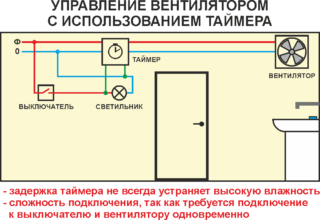The forced exhaust hood in the bathroom or toilet is powered by electricity, therefore, a wire line must be supplied to the place of its installation. Power is usually supplied through a switch in order to be able to control the operation of the device. You can organize the fan connection in different ways, here everyone chooses the most suitable scheme for themselves. In most cases, the task is simplified by combining lighting with a supply and exhaust system. This solution has its own advantages and disadvantages.
- Rules for choosing an electric fan for a bathroom
- How to check natural ventilation
- Connecting a bathroom fan to a switch
- Separate toggle switch for device
- Connection via a one-button switch
- Application of a two-button switch
- Connecting a fan with a timer
- How to organize air exchange in the shower
- Installing an electric fan
- Wall execution
Rules for choosing an electric fan for a bathroom
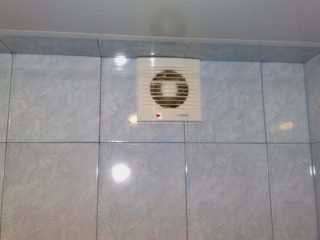
There are many exhaust devices on sale, but you cannot take the first device you like, it is important to know its technical characteristics and the conditions in which it will work. In order for the microclimate in the shower room to be within acceptable aisles in accordance with sanitary standards, the following points must be taken into account:
- What power should the device be. This refers to its performance. This parameter directly depends on the area of the room where the hood will be installed.
- Seat diameter. The ventilation pump itself must fit into the pre-laid channel and the supply wires must pass freely;
- Additional features. There are devices with a timer, engine speed control, mechanically closing curtains from drafts, a motion or light sensor.
An important parameter influencing the choice may be the noise of the operating installation. If the level of decibels generated exceeds the recommended threshold, it will be difficult to operate the electric fan near sleeping rooms.
How to check natural ventilation
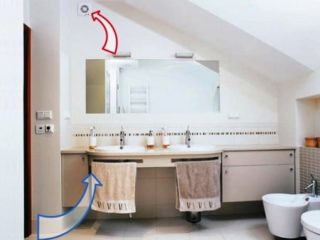
If a natural ventilation system is incorporated in the building design, it is possible that there is no need to equip a forced exhaust. To be convinced of this, it is necessary to check the structure for operability. The verification methods are as follows:
- Checking the draft in the channel. To do this, light a match and bring it to the channel entrance. If the flame rushes towards the hole, there is a thrust. It is recommended to carry out control in warm, windy weather, when the parameters of the pressure drop are always at a minimum.
- Analysis of the efficiency of drying the room. For this purpose, the shower room is filled with steam: hot water is opened through a diffuser and for some time it is drained. Next, they look at how abundantly water droplets form on the walls of the room and how long it does not dry out.
If the humidity goes away quickly, natural circulation is quite enough for the organization of high-quality air exchange in the toilet or bathroom. Otherwise, it is necessary to install an additional electric ventilation pump.
Connecting a bathroom fan to a switch
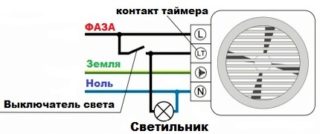
The electric fan is not connected directly to the supply line, but through a toggle switch or switch. Usually there is no need for its continuous operation, especially in the summer, when you can open a window and ventilate the bathroom. Switches are single, double and multi-key.To organize the operation of an electric motor with an impeller, the first two options are sufficient.
Separate toggle switch for device
The best option would be to install a separate switch on the ventoextractor.
- You can turn on the electric fan at any time and not use it strictly with the light on, as in the option with parallel power from a light bulb.
- When repairing the device, it is easier to disconnect it from the voltage for safety reasons.
It is not always possible to implement such a connection scheme to the fan switch if the room is finished, therefore the wires are laid during the construction phase. A separate switch is an additional cost and you need to find a free space to install it.
There are electric exhaust fans with a built-in toggle switch and a control system in the form of a hanging cord. For such devices, only a line feed can be made.
Connection via a one-button switch
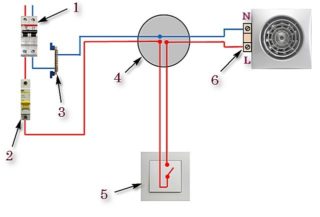
If a tile has already been laid in the shower room, and it is not possible to remove it, and you need to make a supply of electrical power, you can do it simply - take power from the lighting bulb by connecting to it in parallel. Then the ventilation pump will work simultaneously with the light. The wires can be fed from the luminaire through a plastic box.
This option is also good from an economic point of view, since you do not need to spend money on an additional switch, the cable will go less. The only drawback here will be the very principle of operation - only when the light is on. This is inconvenient, since drafts are felt during bath procedures, sometimes you have to leave the light on in order to completely remove wet steam from the room.
Application of a two-button switch
At the design stage of installing a fan in the bathroom, you can immediately provide a line for powering the electrical appliance from a double switch, on which lighting will also hang. This is convenient and profitable, since a toggle switch with two keys costs a little more than a one-key switch and is cheaper than two separate switching elements. Otherwise, all the advantages that are inherent in a separate power supply of the hood also apply here. It is only important to remember which key is which line, so as not to get confused and not leave the light, thinking that it works by blowing.
Powerful wires should not be connected under the exhaust ventilation pump, usually the amount of watts consumed by household appliances is insignificant.
Connecting a fan with a timer
- Turn on at the moment when the light comes on and stop working after a certain time after turning off the light. The delay in this case can be fixed or configurable.
- The engine is started after the lamp has gone out.
The latter option is more comfortable, as it relieves residents of the inconvenience in terms of drafts and noise of the operating unit at the time of using the bathroom or toilet. To implement the project of a hood with a timer, a three-core cable is required, where two lines are supply lines, and one wire is a signal one.
How to organize air exchange in the shower

The room for receiving bath procedures must be equipped with supply and exhaust ventilation without fail, for this there are several reasons:
- This is an area of high humidity, which in itself cannot be dried with a simple heater;
- In most cases, bathrooms do not have windows, which excludes the possibility of using simple ventilation.
The standard equipment of the exhaust system includes a suction unit and an air supply device.As the latter, the usual device for the lower part of the interior door - a decorative mesh, can be used. Then the air exchange will be carried out by connecting the room with other rooms.
If there is no possibility to modernize the door, the inflow can be organized by means of an inlet valve or a recuperator can be used in the bathroom. In the latter case, one organized channel in the wall will perform two functions at once: intake and air supply. The system can be powered from a separate switch.
When building a new building, it is advisable to include small vents in the upper part in the bathroom and toilet project. This will allow you to use only ventilation in the summer.
Installing an electric fan
Installing a hood is not a complex technical undertaking, but it still requires certain skills in the construction field, or at least an understanding of these processes. The most important thing is to decide on the place where the ventilation pump itself will be placed. According to the rules, this should be the highest point in the area where steam is most likely to form or simply a large accumulation of moisture. If you take a shower or a bathroom, this is directly the area where the tap is located, in the toilet there is a toilet bowl.
Wall execution
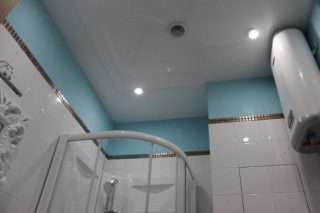
To connect a bathroom fan on the wall, you need to do the following:
- Mark on the working plane of the wall the seat for the body. To do this, a plastic pipe with a diameter slightly larger than the diameter of the seat itself is applied with its end to the tile or concrete and outlines a circle.
- Using a diamond bit, a channel is drilled in the wall to the street. This can be done with a hammer drill and hammer drill.
- The pipe from the outside is covered with a thin layer of polyurethane foam-glue and inserted into the resulting channel.
- In order not to remove the tiles and supply electricity to the unit, the tile joint is selected and a flat two-core wire is inserted there, laying it to the place where the light switch is installed. They make commutation to it.
- The product is connected to electricity, a layer of liquid nails is applied to the landing panel from the inside out and the apparatus is inserted into the ventilation pipe.
Then they turn on the device and check how it works. There should be no extraneous noise and vibration.
You can simplify the process and simply connect the motor to a light bulb. To do this, you do not need to groove the tile seam, it is enough to purchase a plastic box in which the electrician is laid. The box itself is glued to the tile, leading it to the lamp. Next, the cable is connected to the cartridge and laid to the vented pump.

